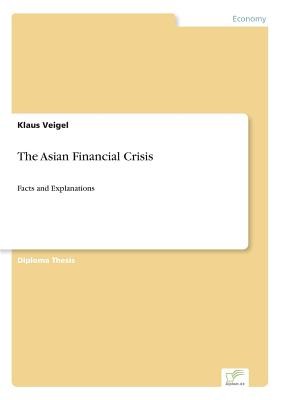
- We will send in 10–14 business days.
- Author: Klaus Veigel
- Publisher: Diplom.de
- Year: 1999
- Pages: 130
- ISBN-10: 3838615689
- ISBN-13: 9783838615684
- Format: 14.8 x 21 x 0.8 cm, softcover
- Language: English
- SAVE -10% with code: EXTRA
Reviews
Description
Inhaltsangabe: Abstract: "Macroeconomic stability and rapid export growth were the two key elements in starting the virtuous circles of high rates of accumulation, efficient allocation, and strong productive growth that formed the basis for East Asia's success." (World Bank, 1993). Public perception of the Asian economies could hardly have shifted more since that time. Currency depreciation, rising corporate bankruptcy, bank failures, and sovereign bonds downgraded to junk bond status ended the euphoria in Asian "emerging markets". Almost overnight, the reputation of the Newly Industrialized Countries (NICs) in East and South East Asia deteriorated from a model of efficient development to an example of worst crony capitalism". Politicians, rating agencies, and investors were caught off guard by the development of the Asian financial crisis. During the meeting of the Asia-Pacific Economic Co-operation forum (APEC) in November 1997, U.S. President Bill Clinton referred to the financial crisis in Asia as merely a few small glitches in the road". Moody's and Standard and Poor's had upgraded the Philippines' long term debt rating a few months earlier and downgraded the affected economies only when the crisis persisted for more than three months. Com-paring Thailand's situation to Mexico's economy prior to the peso crisis 1994-1995, the Morgan Stanley star analyst Barton Biggs wrote in January 1997: "Thailand's problems are cyclical, not secular. Thailand is not Mexico in late1994. [..]On the numbers, Thailand qualifies for the euro and is healthier than Germany". The optimism seemed warranted by a history of high growth in the Asian countries. Before the outbreak of the crisis, Malaysia, Indonesia, Korea, and Thailand had experienced uninterrupted growth of more that 5 percent of GDP per year for almost two decades. The economic profession also experienced its Waterloo in Asia. Economists not only failed to predict the crisis; they also failed to recognize the vulnera
EXTRA 10 % discount with code: EXTRA
The promotion ends in 18d.16:52:38
The discount code is valid when purchasing from 10 €. Discounts do not stack.
- Author: Klaus Veigel
- Publisher: Diplom.de
- Year: 1999
- Pages: 130
- ISBN-10: 3838615689
- ISBN-13: 9783838615684
- Format: 14.8 x 21 x 0.8 cm, softcover
- Language: English English
Inhaltsangabe: Abstract: "Macroeconomic stability and rapid export growth were the two key elements in starting the virtuous circles of high rates of accumulation, efficient allocation, and strong productive growth that formed the basis for East Asia's success." (World Bank, 1993). Public perception of the Asian economies could hardly have shifted more since that time. Currency depreciation, rising corporate bankruptcy, bank failures, and sovereign bonds downgraded to junk bond status ended the euphoria in Asian "emerging markets". Almost overnight, the reputation of the Newly Industrialized Countries (NICs) in East and South East Asia deteriorated from a model of efficient development to an example of worst crony capitalism". Politicians, rating agencies, and investors were caught off guard by the development of the Asian financial crisis. During the meeting of the Asia-Pacific Economic Co-operation forum (APEC) in November 1997, U.S. President Bill Clinton referred to the financial crisis in Asia as merely a few small glitches in the road". Moody's and Standard and Poor's had upgraded the Philippines' long term debt rating a few months earlier and downgraded the affected economies only when the crisis persisted for more than three months. Com-paring Thailand's situation to Mexico's economy prior to the peso crisis 1994-1995, the Morgan Stanley star analyst Barton Biggs wrote in January 1997: "Thailand's problems are cyclical, not secular. Thailand is not Mexico in late1994. [..]On the numbers, Thailand qualifies for the euro and is healthier than Germany". The optimism seemed warranted by a history of high growth in the Asian countries. Before the outbreak of the crisis, Malaysia, Indonesia, Korea, and Thailand had experienced uninterrupted growth of more that 5 percent of GDP per year for almost two decades. The economic profession also experienced its Waterloo in Asia. Economists not only failed to predict the crisis; they also failed to recognize the vulnera


Reviews